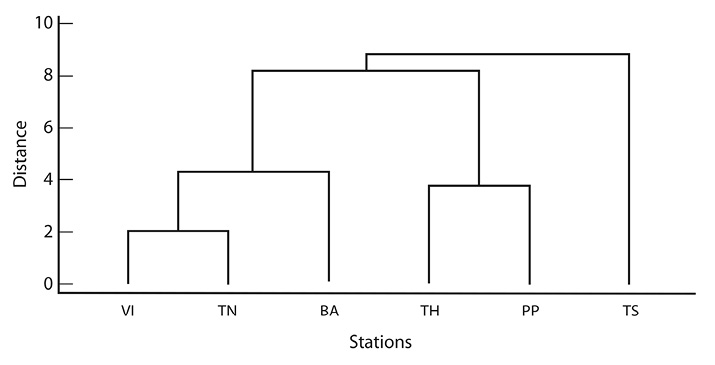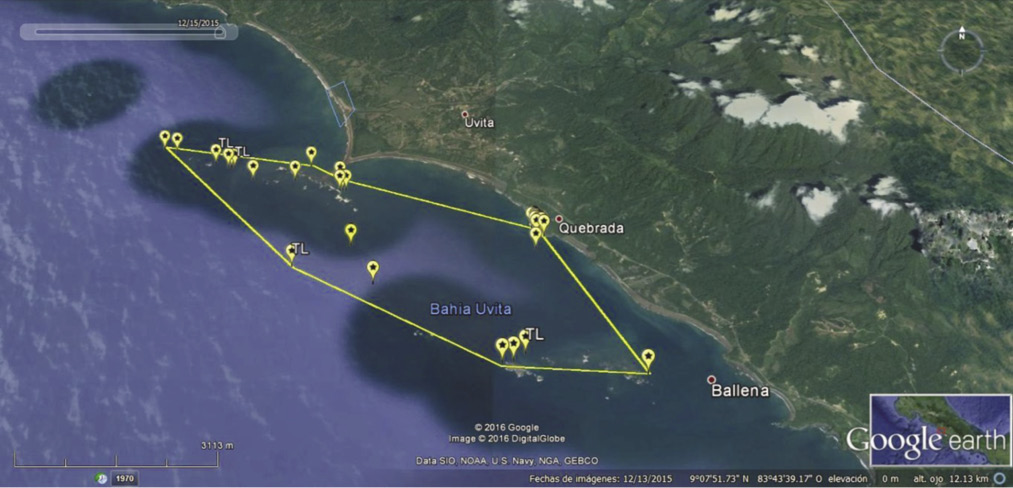
Potential foraging and aggregation zones of the Hawksbill Sea Turtle Eretmochelys imbricata (Testudines: Cheloniidae),
in Marino Ballena National Park, Costa Rica
Adrián Bonilla-Salazar & Oscar Brenes Arias
Programa de Conservación de Tortugas Marinas, Reserva Playa Tortuga, Ojochal de Osa, Puntarenas, Costa Rica;
chile87@gmail.com, oscarbreari@gmail.com
Received 18-X-2016 • Corrected 20-xi-2016 • Accepted 03-xii-2016
Abstract: Groups of hawksbill sea turtles have been observed over the years, close to the coast of the Marino Ballena National Park. For this reason, in February 2015, we monitored its coast to identify aggregation sites. Turtle size estimates, and identification, were done by direct observation by the divers and from the boat. From February to December 2015, fourteen monitor records per sampling point were done and 41 turtles were recorded. They were 30cm - 80cm long and 59% of the individuals aggregated in one sample point. Five genera of sponges were registered as potential food: Haliclona sp., Spirastrella sp., Mycale sp., Aplyscina sp. and Axinella sp. and one tunicate, Rhopalaea birkelandi. The E. imbricata population was mainly composed of juveniles, and the turtles were found in zones where they have not been previously reported.
Key words: Hawksbill, National Park, South Pacific, Foraging, Aggregation, Costa Rica.
The hawksbill is characterized as the most “tropical” turtle of all sea turtles species. It is typically found in tropical and subtropical waters in the Atlantic, Pacific and Indian oceans. It is common to see these animals in coral reef areas, rocky areas, estuaries and coastal lagoons. Their diet consists mostly of sponges, but they also consume anemones, squid and shrimp. The hawksbill turtle plays an important ecological role in the health of the coral reef ecosystem since they are highly selective, feeding on only specific types of sponges and providing the opportunity for other species to compete for space and food on the reef (Dick, 2005).
Over the years, the number of hawksbill populations have declined drastically due to poaching of their eggs and shells, and the excessive development in areas that affect coastal spawning (Carrion-Cortez, Canales-Cerro, Arauz, & Riosmena-Rodriguez, 2013).
In the Eastern Pacific, telemetry studies in adults have shown that this species is often found in estuaries and mangroves, as well as feeding areas near the coast with hard bottoms, such as coral reefs or sponge groups (Carrion-Cortez et al. 2013).
The hawksbill turtle (Eretmochelys imbricata) is on the IUCN Red List criteria, and since 1996, considered a Critically Endangered species, due to an 80% decline in the world population during the last three generations (Meylan & Donnelly, 1999).
The objective of this study is to confirm the presence of the hawksbill sea turtle in the areas influenced by the Marino Ballena National Park. This is done by: identifying the actual zones used by this species, describing the food resources available, and identifying other potential foraging areas for these sea turtles in the parks marine area.
MATERIALS AND METHODS
The Marino Ballena National Park (PNMB) (83º45’W y 9º09’N) is located in the canton of Osa, Costa Rica, in the northern sector of the Osa Conservation Area (ACOSA), between Piñuelas Beach and Morete River. It currently has an area of 5,375 marine hectares and 110 hectares of land. The communities of Santo Tomás, Playa Hermosa, Ballena, Uvita and Bahia are adjacent to the National Park (Solís & Madrigal, 2004). The area is characterized by having moderate to heavy rainfall with an annual rainy season between 3000-3500 mm, and a dry season from December to March with an average temperature between 23°C to 27°C (Alvarado, Cortez, Fernandez & Nivia, 2005).
Since February 2015, six sample points were established along the coast of the park to perform a formal monitoring of the aggregation sites of the hawksbill sea turtle. The sampling points were chosen from locations where groups of hawksbill sea turtles have been reported over the years by tour operators and researchers, close to the coast of the Marino Ballena National Park.
The sample points are: Tómbolo Sur (TS) (83°45’18.20” W, 9°8’28.69” N), Tómbolo Norte (TN) (83°46’8.18” W, 9°9’3.44” N), Roca La Viuda (VI) (83°46’56.21” W, 9°9’5.48” N), Isla Ballena (BA) (83°43’31.48” W, 9°6’22.99” N), Tres Hermanas (TH) (83°42’24.25” W, 9° 6’16.62” N) and Punta Pargo (PP) (83°43’23.11” W, 9°8’0.65” N).
Sea Turtle: The turtles were identified and size estimated by direct observation, using divers and from a boat. To determine the maturity of the turtles, the minimum size of maturity reported by Carrion-Cortez et al (2013), at Caletas Beach was used. Turtles below 70cm were considered juveniles and those above were considered adults. Their locations were recorded with a Global Positioning System (GPS). Dives were performed at each point to inventory the potential food resources available for the species, and compared with the literature of other areas along Costa Rica’s Pacific coast.
Seabed Quantification: To study the composition and abundance of the species that are found at the seabed, we sampled randomly using two 10m long transects, separated by 5m each per site and 1m2 quadrants (Weinberg, 1981).
Environmental Factors: Habitat descriptions were taken at each excursion zone, including: water turbidity, water temperature, sampling point depth, and salinity. An ANOVA test was performed to compare the values of each station.
RESULTS
Between February 2015 to December 2015, a total of fourteen monitoring trips were performed working eight hours per day between the hours of 8:00 to 16:00. Hawksbill sea turtles were observed in all the stations inside an area of 17.1 square kilometers (Fig. 1). The total monitoring effort was 112 hours, with 41 observations of E.imbricata and four of Lepidochelys olivacea (Fig. 2). The number of observations by sampling unity total was equal to 0.40 turtles per hour, with a number of 0.37 hawksbill per hour and 0.036 olive ridley per hour.
Eight percent of the hawksbill sea turtles observed were classified as adults with a size greater than 70cm. Another 25% were classified as juveniles reaching maturity between 50cm to 70cm, and 67% of individuals were juvenile, between 30cm to 50cm. The study found that 59% of all the hawksbills turtles remained in the Punta Pargo (PP) area, followed by 10% in Viuda Rock (VI) and Tombolo Sur (TS) areas, and 7% in Ballena Island (BA) and Tombolo Norte (TN) areas, 5% between Tombolo Sur and Ballena Island and 2% in Tres Hermanas (Fig. 3).
A total of 19 species were counted in the study area. The coral Porites lobata was the most abundant specie in Tómbolo Sur (57%) and Tres Hermanas (74%), and the coral Leptogorgia sp. was the most abundant in Viuda (22%) and in Punta Pargo (53%).The sponge Mycale sp. was the most abundant in Tombolo Norte (34%), (Table 1).
The results of the three diversity index performed for each sampling area shows Ballena island (BA) as the most diverse based on two index Shannon and Simpsons, the second is Viuda rock (VI) and the third one Tombolo Norte (TN). For Berger-Parker who considers the species dominance, the most diverse was VI, second BA and third TN (Table 2).
Based on ANOVA testing, there was no significant difference p>0.05 of salinity within the sample points. Water temperatures were similar in all the stations with average values between 31.88°C in PP and 30.48°C in TS. Punta Pargo (PP) recorded the highest point of turbidity (2.92m), but there were no differences between stations. Viuda Rock (VI) has the maximum diving depth (11.5m) and Tombolo Sur (TS) with 4.78m has the lowest diving depth (Fig. 4).
In the study area, one species of tunicate Rhopalaea birkelandi (RB) was present in five of the six points; only in Punta Pargo (PP) was there no record of this or any other tunicate. Of the five sponge species registered in the study area, Mycale sp. (Msp) was the most abundant in Viuda (VI), Tombolo Norte (TN), Tres Hermanas (TH) and Punta Pargo (PP). Aplysina sp. (Apsp) was the most abundant in Tombolo sur (TS) and Spirastrella sp. (Spi) was the most common in Ballena (BA), (Fig. 5).
Based on a Cluster analysis with physical variables and species composition we found that the station (TS) is completely different from the other five stations. There were similarities between the stations (VI) and (TN) which are closer to (BA). Stations (TH) and (PP) also share the same levels (Fig. 6).
DISCUSSION
This research found that hawskbill sea turtles were observed in places within the National park where they have not been reported before (Tombolo Norte, Tombolo Sur and Viuda Rock) by previous researches in the same area like Venegas- Li, Palacios & Martínez, (2015), who previously counted hawskbills, only observed them in Punta Pargo, Ballena and Tres Hermanas. We can conclude this because our research spent more time monitoring the same area during the year focusing solely on turtles compared with Venegas-Li et al (2015) who carried out their monitoring during the whale season, and worked with tour operators who focus more on whales than turtles. In addition to this the previous study monitored mainly within the south of the park, leaving Viuda and Tombolo Norte and Sur a little isolated from the rest.
The number of turtles by sampling effort showed more sightings of E.imbricata than that reported by Venegas-Li et al (2015) of 0.05 Hawksbill per hour, but a lower value for other species like olive ridley and green turtles. It is likely that this occurred because the monitoring was conducted in places close to the coastline where the presence of E.imbricatta was reported, reducing the probability of encountering the green and olive ridley turtles usually found more frequently in open ocean.
The physical factors showed values of average salinity and temperatures higher than that recorded by Alvarado, Fernández & Cortes, (2009). It is likely that this is attributed to the ‘’El Niño” effect during 2015 which produced dry conditions throughout the year increasing the water temperature, and salinity due to high evaporation and low discharge of water from the rivers by the lack of rain.
We found that there was increased turbidity in the water in Punta Pargo, Tombolo Sur and Tres Hermanas, this result could be due to the proximity to the coast where by the waves and tide changes cause suspended sediment (Borok, 2014), also this research is close to the Terraba River, the bigger river in the country, and during rainy season causes high turbidity in the area.
The presence of E.imbricata between the stations can be attributed to the availability of food sources such as sponges Axinella sp. Aplysina sp., the tunicate Rhopalaea birkelandi, algae Padina sp. and the soft coral Pacifigorgia sp.. These food sources have already been reported as part of the normal diet of the hawksbill turtles present in the area by Carrión-Córtez et al. 2013.
In Punta Pargo, where more turtles were observed n=24, the sponge Mycale sp. was the dominant species and none of the other potential food sources were recorded. The abundance of this sponge and the number of turtles in the area, suggest that Mycale sp. is part of the turtles diet. This assumption is supported by the results of the richness index, which shows that the station has a low diversity of species but a higher number of turtles. However, it is necessary to conduct a stomach content analysis in the future to confirm this.
In other stations with a higher diversity such as Ballena Island (BA), only three observations were confirmed from the research.
In conclusion, it can be confirmed that hawksbill sea turtles were found in zones where they have not been previously reported. From this research it was possible to complete an inventory of the potential food sources of the turtles as well as identify different species and their distribution along the study sites. The research found that the E. imbricata population was mainly composed of juveniles, however other species of sea turtles were also found to be present at all stations. Finally, a recommendation from this research is that further studies are conducted, particularly in Punta Pargo to determine why the turtles have a preference for this area, as opposed to other areas with higher food source availability.
A new stage in this research requires individuals to be captured in order to perform an esophagus content analysis to determine what the turtles are eating, in order to identify other factors that could explain why more turtles are detected in one station in comparison with the others. Tagging is also required in order to more accurately estimate the number of individuals as well as their local movements.
ACKNOWLEDGMENTS
We would like to thank the Reserva Playa Tortuga Founders for supporting the research, the Osa Conservation Area and the Marino Ballena National Park authorities, and to EcoDivers.cr and Yubarta Tours for the logistics and collaboration during the project.
REFERENCES
Alvarado, J. J., Cortez, J., Fernandez, C., & Nivia, J. (2005). Comunidades y arrecifes coralinos del Parque Nacional Marino Ballena, costa del Pacífico de Costa Rica. Ciencias Marinas, 31(4), 641–651.
Alvarado, J. J., Fernández, C., & Cortes, J. (2009). Water quality conditions on coral reefs at the Marino Ballena National Park, Pacific Costa Rica. Bulletin of Marine Science, 84(2), 137-152.
Borok, A. (2014). Turbidity Technical Review Summary of Sources, Effects, and Issues Related to Revising the Statewide Water Quality Standard for Turbidity. Oregon Department of Environmental Quality.
Carrion-Cortez, J., Canales-Cerro, C., Arauz, R., & Riosmena-Rodriguez, R. (2013). Habitat use an diet of juvenile Eastern Pacific Hauksbill Turtles (Eretmochelys imbricata) in the North Pacific Coast of Costa Rica. Chelonian Conservation and Biology, 12(2), 235-245.
Dick, B. (2005). La Tortuga Carey (Eretmochelys imbricata). Secretaría Pro Tempore de la Convención Interamericana para la Protección y Conservación de las Tortugas Marinas (CIT), San José, Costa Rica.
Meylan, A. B., & Donnelly, M. (1999). Status justification for listing the hawksbill turtle (Eretmochelys imbricata) as Critically Endangered on the 1996 IUCN Red List of Threatened Animals. Chelonian Conservation and Biology, 3(2), 200-224.
Solís, V., & Madrigal, P. (2004). El Manejo Colaborativo del Parque Nacional Marino Ballena como instrumento de manejo alternativo de conflictos: sistematización de la experiencia. Coope SoliDar R.L.
Venegas, L., Palacios, R., Martínez, D. (2015). Agregación costera de tortugas marinas en aguas del Pacífico Sur de Costa Rica. Revista Biología Tropical, 63(1), 1-8.
Weinberg, S. (1981). A comparison of coral reef survey methods. Bijdragen Tot De Dierkunde, 51(2), 199-218.
Resumen: Identificación y caracterización de zonas de forrajeo y agregación para la Tortuga Carey en el Parque Nacional Marino Ballena, Costa Rica. Grupos de tortugas carey han sido observados por agencias turísticas e investigadores durante años cerca de la costa del Parque Nacional Marino Ballena. Desde febrero 2015 se comenzó a monitorear la costa del parque para generar información sobre sitios de agregación de la tortuga carey. La identificación y el tamaño de la población se realizaron por observación directa por personal calificado desde una embarcación y durante buceos. Los buceos se realizaron con el fin de levantar un inventario del potencial recurso alimenticio para esta especie. Entre febrero y diciembre del 2015, 14 monitoreos fueron ejecutados en cada zona de muestreo, 41 tortugas carey fueron observadas, las cuales se estimó un tamaño entre los 30cm a 80cm, 59% de estas fueron observados en el sector de Punta Pargo. Cinco géneros de esponjas fueron encontrados como posible alimento, Haliclona sp., Spirastrella sp., Mycale sp., Aplyscina sp. y Axinella sp., además de una especie de tunicado (Rhopalaea birkelandi). Esta investigación encontró que la población de tortuga carey está compuesta por juveniles en su mayoría, además de haberse encontrado tortugas carey en zonas donde estas nunca antes fueron reportadas dentro del parque.
Palabras clave: Carey, Parque Nacional, Pacífico Sur, Agregación, Zonas de forrajeo, Costa Rica.

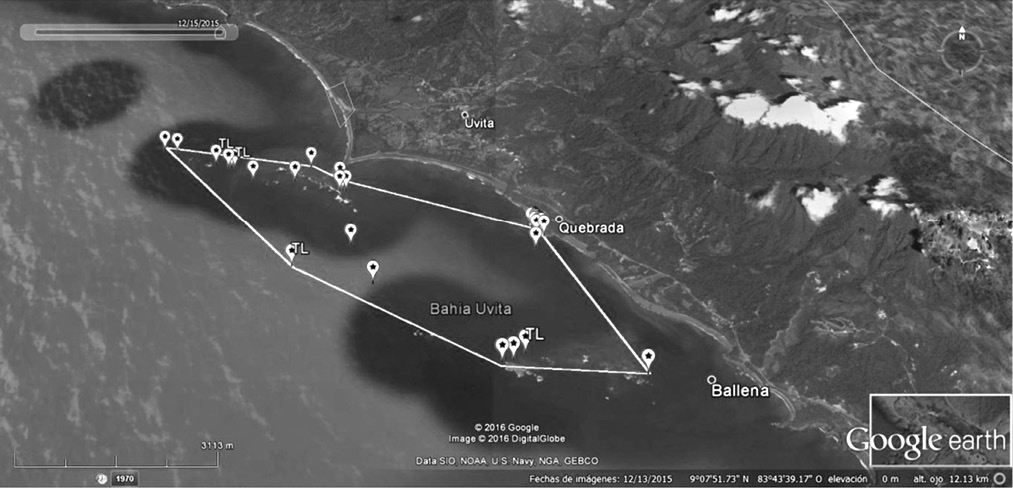
Fig. 1. Number of turtles seen at Marino Ballena National Park. A total of 45 turtles were observed in the area; 41 were hawksbills and four olive ridley (TL) in an area of 17.1 square kilometers was covered during this study.
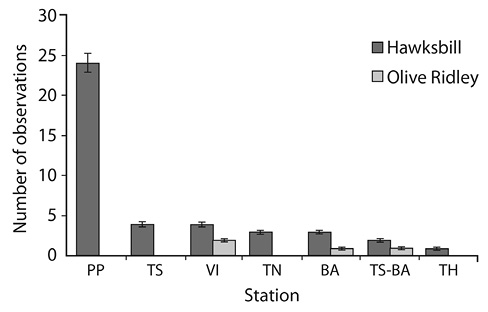
Fig. 2. Number of turtles viewed in every sampling point.
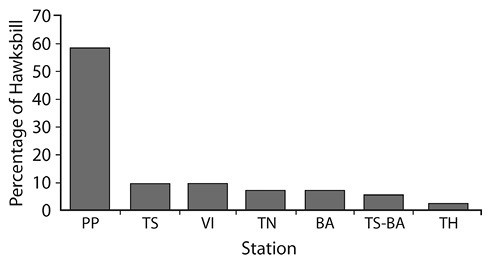
Fig. 3. Percentage of Hawksbill turtles in every sampling point.
TABLE 1
List of the species recorded after diving at the six stations at the Marino Ballena National Park,
between February 2015 to August 2015
|
Species |
Abreviations |
Station |
|||||
|
Corals |
|
TS |
TN |
VI |
BA |
3H |
PP |
|
Porites lobata |
PL |
x* |
x |
x |
x |
x* |
|
|
Pocillopora damicornis |
PD |
x |
x |
x |
x |
x |
|
|
Leptogorgia rigida |
LR |
|
x |
|
x |
x |
|
|
Leptogorgia alba |
LA |
|
x |
x |
x |
x |
x |
|
Leptogorgia sp. |
Lsp |
x |
x |
x* |
x |
x |
x* |
|
Pacifigorgia sp. |
Psp |
|
x |
x |
x |
x |
|
|
Tunicates |
|||||||
|
Rhopalaea birkelandi |
RB |
x |
x |
x |
x |
x |
|
|
Echinoderms |
|||||||
|
Pharia pyramidatus |
PPy |
|
x |
|
|
|
x |
|
Phataria unifascialis |
Pun |
x |
x |
x |
|
x |
|
|
Pentaceraster cumingi |
PCu |
|
|
x |
x |
|
|
|
Diadema mexicanum |
DM |
x |
|
x |
x |
|
|
|
Eucidaris thouarsii |
ET |
|
|
|
|
|
|
|
Porifera |
|||||||
|
Haliclona sp. |
Hsp |
|
x |
x |
x |
x |
x |
|
Spirastrella sp. |
Spi |
|
|
|
x |
x |
x |
|
Mycale sp. |
Msp |
x |
x* |
x |
x |
x |
x |
|
Aplysina sp. |
Apsp |
x |
x |
x |
x |
x |
|
|
Axinella sp. |
Axsp |
|
x |
x |
x |
x |
|
|
Algae |
|||||||
|
Sargassum sp. |
Ssp |
|
|
x |
|
|
|
|
Padina sp. |
Pad |
x |
x |
x |
x* |
x |
|
|
Mollusc |
|||||||
|
Strombus galeatus |
SG |
x |
|
|
x |
|
|
* Denotes the most abundant species.
Fig. 4. Average values from the four physical factors recorded at each sampling zone in Marino Ballena National Park between February 2015 to December 2015.
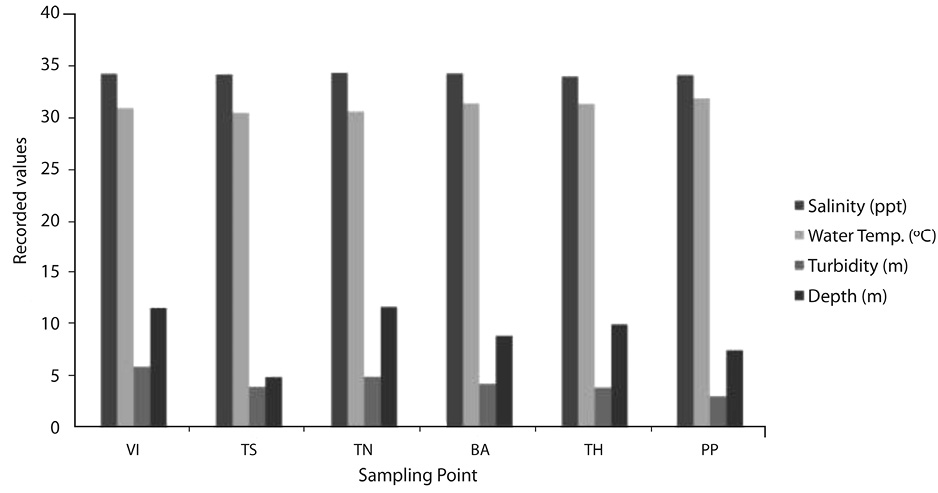
Fig. 5. Percentage of potential food resource for the hawksbill sea turtles recorded in six different points in the Marino Ballena National Park. *Sponges **tunicates.
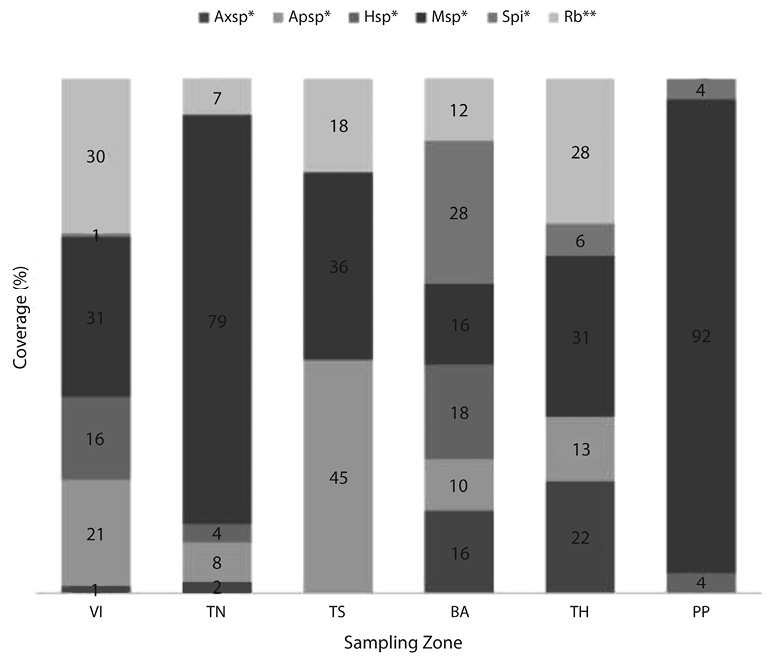
Table 2
Alfa diversity index estimated for each Sample zone
|
Sample |
Species N.º |
Shannon H |
Variance H |
Simpsons d |
Berger-Parker |
|
TN |
14 |
2.044*** |
0.0009297 |
5.516*** |
0.3421*** |
|
BA |
16 |
2.364* |
0.0007198 |
8.027* |
0.2492** |
|
TS |
12 |
1.146 |
0.001759 |
2.079 |
0.6694 |
|
VI |
17 |
2.182** |
0.0006302 |
7.368** |
0.236* |
|
TH |
14 |
1.017 |
0.00192 |
1.728 |
0.7505 |
|
PP |
6 |
1.136 |
0.0006201 |
2.597 |
0.5315 |
* First in diversity. ** Second in diversity. *** Third in diversity.
Fig. 6. Cluster analysis based on physical variables and the species composition by station.
